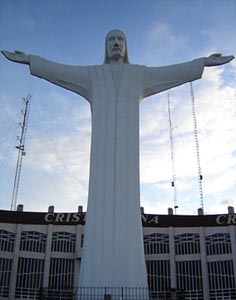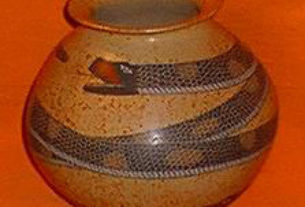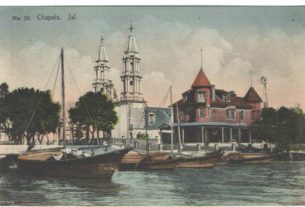Westwords

You may have already heard that Mexico is a big nation. It is bigger than big. It is vast — and diverse. There are many places to go and many different things to see. For 17 years we have been here and there, and done this and that, and are still looking.
Once, on our way from El Paso to Guadalajara, we paused in Torreon, a city of half a million or more in the state of Coahuila, 275 miles down good roads from the Texas border, out in the middle of the north country as the crow might fly from Monterrey to Los Mochis.
Our primary aim was to see the very large sculpture of Jesus Christ, 70 feet tall, arms outstretched as if blessing or protecting saints and sinners alike.
We knew El Cristo was high on a hill but we were surprised by the religious business development around him, a replica of the Holy Land, a restaurant with a view, a souvenir sales center.
This being Mexico, we shouldn’t have been surprised to learn that it had taken 27 years to get from idea to reality. A priest, Jose Rodriguez Tenorio, proposed the monument in 1973 as a booster shot for Catholics: “The purpose is to reach the invisible through the visible.”
Sculptor Vladimir Alvarado eventually made it happen with 580 tons of steel-reinforced concrete. Amazing!
There are other sights in Torreon — the tower, the thinker’s fountain, the place where Pancho Villa slept more than once, Denny’s on Indepencia, a train museum, the sundial outside the Guadalupe temple, a monument honoring Father Hidalgo, the Museum of the Revolution, plenty of touristy stuff.
The Nazas Theater has been revitalized for plays, concerts, even opera. It is a showplace.
Several times since, we have talked about returning to Torreon to see more of what we missed. I know why we didn’t go. All hell broke loose. Murders became the primary statistic. A gang took over the prison. The city fired supposedly corrupt police.
What had been a very progressive region, a mix of manufacturing, mining and farming, became a battleground, incoming Zetas against the more established Sinaloa cartel. What followed were shootouts and massacres and bags of severed heads.
There was a very vivid quote from a former mayor: “It’s a powder keg!”
How come it happened in Torreon? It is a four-way intersection, a crossroads from south to north and west to east.
The outbreak last August was unsettling but we think it is now some better, not Paradise restored, never Utopia, but reasonably safe enough to go for another look.
We had always hoped to take a ride on the little passenger train from Torreon to Cañitas de Felipe Pescador. It was a relic from another era, one round trip per week.
Mexico has more than 12,000 miles of railroad tracks. For more than a hundred years, trains hauled people. Trains, at their peak, supposedly had 37.4 million passengers in 1972. By the early 1990s, most travelers took the bus.
Passenger trains, fading away, dropped out sharply after privatization of the rail industry in 1996. Primary survivor is the Copper Canyon line in the Sierra Madres.
Trains now haul things, including giant canisters on flat cars. It appears trains remain at least half of the backbone of the $1 billion-a-day trade partnership between Mexico and the United States.
The Torreon to Felipe Pescador line, one engine, one or two cars, was not an ornament. It existed because it was subsidized by Zacatecas state to serve a remote segment of the population. It may have been designed specifically for school teachers traveling from the big city to La Mancha, Symon, San Isidro, Camacho, Opal, Pacheco and La Colorada — or it could have been primarily for shoppers and salesmen who had things to buy or sell during a weekend in Torreon.
It started northbound at 3 p.m. on Friday from Felipe Pescador and southbound from Torreon at 3 on Sunday. The long haul was about six hours. Round-trip price was 324 pesos. For most people, it was more than a joy ride. The train started in one state, ended in another and worked in and out of Durango.
We heard there were at least a few fantastic views along the way and an interesting canyon between Picadias and Juan Engenio. We were warned that the train shook, rattled and rolled on curves and that air conditioning and interior lights rarely worked.
From our perspective, it sounded like an adventure. Train management wasn’t too picky. It would pick up anything and everything, from fruit and vegetables to auto tires. Sacks of beans and potatoes were common at harvest time. There was a year when one passenger brought his motorcycle aboard each weekend.
The stations were picture postcards, much as they were long, long ago. We were told the locals turned out in the little towns to wave to the crew and riders.
The passenger train was a lifeline for many who lived in the remote villages. Alas and alas, it died a natural death in 2012. Noe Rocha in Contraluz-on-line described the void: loneliness, unemployment and tears, many tears…
The digital publication made the loss very personal when it told of vendors with their baskets filled with snacks and goodies, waiting to sell to those on the train — who would never return. It told of the old man who walked every day to the railroad station, just in case the train changed its mind and came again.
Indeed, in such places, hope is last to die.
The passenger train is an object lesson. For those who depended on it, the loss was a terrible blow. For us, it was just a disappointment. So, we missed the train.
For us, adjustment is easy. We’ll find something else of interest. I do believe we’re going back to Torreon. Those from La Mancha, Symon, San Isidro, Camacho, Opal, Pacheco and La Colorada probably won’t be there.


